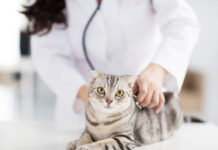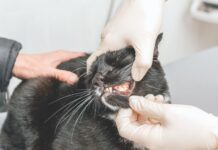Q: My wonderful rescued cat scratches hot spots occasionally. They look just awful but heal nicely and the hair comes back and fills the spot in. I keep an eye on them for infections, but none has ever become infected. What on earth causes my cat to do this to herself? She’s an only cat and there has not been any change in the food I feed her.
Sincerely,
Hot Under the Fur
A: Hot spots, otherwise known as acute moist dermatitis, may develop in cats in a number of circumstances. These lesions are usually characterized by loss of hair, redness, swelling, and sometimes oozing. Cats who have them will often chew at these spots aggressively and incessantly. In fact, the trauma induced by chewing or scratching at the spot is the primary cause and perpetuating factor in this often frustrating dermatologic condition, with more chewing causing more damage to the skin, with resultant increased inflammation and irritation, and a motivating factor to chew the area even more.
The initiating factor in cats that develop hot spots is variable. Ectoparasites such as fleas, ticks or mites may irritate your kitty’s skin to the point where she will start the vicious cycle of trauma, inflammation, irritation and more chewing and trauma. The bites of other insects, such as mosquitoes, may also begin the vicious cycle that ultimately leads to a hot spot, as can poor grooming that may led to matting of hair and chewing and licking by the kitty.
Inhalant allergies (also known as atopy) to things like grasses or dust mites, or allergies to an ingredient in your cat’s diet may also make her itch, which can make her scratch and chew her skin as well. Importantly, some cats may develop allergies to things (such as food) that they have previously had no problem with. Hot spots may also form when a cat scratches or chews an area of her body because of some problem in that specific spot, as when a cat chews at the base of her tail because of an infected anal gland.
Finally, some cats appear to predispose themselves to hot spots by chewing or scratching incessantly when they are bored or stressed, as may occur when they are left for long periods of time without enrichment or when the owner moves to a new house.
The prevention of hot spots focuses on removing the inciting cause. The use of appropriate products to prevent flea and tick infestation is important in this regard, as is minimizing exposure to mosquitoes or other biting insects by keeping cats indoors when possible. Cats with inhalant allergies may require antihistamines and/or corticosteroids to stop their itchiness, and allergy shots may be helpful in some cats. Those with food allergies may benefit from dietary modification, most commonly by having the protein source in their food changed. Addressing any other medical issues (i.e., an infected anal gland) that incite the cat to scratch or chew is important.
Cats who chew and scratch because of stress may benefit from behavior modifications that minimize it, such as introducing new cats to a household gradually and carefully, spending dedicated quality time with your kitty to show her that you love and support her, and keeping familiar things in the environment when moving. Bored cats can have their lives perked up by providing toys and spending play time with them. A veterinary behaviorist is an excellent resource to assist with cats who may be stressed or bored.
The treatment of hot spots usually involves shaving the affected area, preventing further trauma (by removing the inciting cause and, in extreme cases, by having the kitty wear an Elizabethan collar), keeping the area dry, and in some cases by applying anti-inflammatory ointments. Antibiotics may be prescribed if the skin is infected. Consultation with your veterinarian and/or a veterinary dermatologist is recommended in dealing with hot spots as early as possible to prevent the vicious cycle from advancing too far.
I hope this information is helpful, and thank you for rescuing and taking such good care of your kitty. Hot spots can be frustrating, but with appropriate care and prevention, they can be cured or considerably minimized in most cases. ❖
Best regards,
Elizabeth



